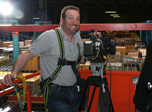Video Production Safety and Preparation
We’ve been fortunate to have shot in some pretty interesting places. The photo shows owner Jay Duchin 60 feet in the air shooting inside a dark and dusty warehouse. Not everyone is comfortableworking on top of a swaying, open air platform tethered to a steel bar. When faced with challenging location environments, it’s really important to let the crew know exactly what they can expect. Most crew members are prepared for seasonal cold or heat, but might be thrown off by a shoot in a walk-in freezer in the middle of August. The following is a list of things that you should communicate to your producer so your crew is prepared:
Heights: The majority of people aren’t comfortable with heights. If your production involves working above ground level, it’s best to advise before hand so no one is embarrassed having to decline a location.
Fluids: Water is the enemy of just about everyone on a crew. It gets on lenses, people, equipment — just about everywhere you don’t want it to be. If you’re prepared for it, it’s not a big deal. However when it’s a surprise, it won’t go over well and might even prevent your shoot from happening.
Safety: Crews are occasionally required to wear an array of safety equipment from full rigging harnesses to hard hats and masks. This makes the already challenging working environment that much more difficult. Occasionally, someone might have a physical restriction from donning specific safety equipment, it’s rare but it does happen and knowing in advance is extremely valuable for everyone involved.
Dirt: Dust and mud get everywhere. It can takes hours to clean and prepare the equipment for the next day. Keep in mind that dust and dirt are irritants that some people are allergic to.
Climbing: Climbing doesn’t always involve heights but it can put added stress on joints and muscles. The problem is further exacerbated when numerous trips have to be made to carry equipment back and forth from location to location. People with recent injuries might not be able to perform the necessary tasks but the problem can be resolved by having an extra person on site to do some of the lugging. Keep in mind, it’s not just a camera that has to be moved, it’s lights, mics, cables, stands, tripods, monitors and whatever else is required to get the shot.
What we want people to take away from this is simply to communicate when a challenging environment might be encountered so everyone can be safe and properly prepared.




